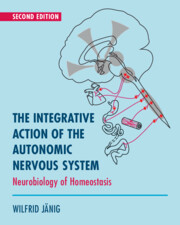Book contents
- The Integrative Action of the Autonomic Nervous System
- Reviews
- The Integrative Action of the Autonomic Nervous System
- Copyright page
- Dedication
- Contents
- Foreword to the Second Edition
- Foreword to the First Edition
- Preface
- Abbreviations
- Introduction The Autonomic Nervous System and the Regulation of Body Functions
- Part I The Autonomic Nervous System: Functional Anatomy and Interoceptive Afferents
- Part II Functional Organization of the Peripheral Autonomic Nervous System
- Chapter 3 The Final Autonomic Pathway and its Analysis
- Chapter 4 The Peripheral Sympathetic and Parasympathetic Pathways
- Chapter 5 The Enteric Nervous System
- Part III Transmission of Signals in the Peripheral Autonomic Nervous System
- Part IV Representation of the Autonomic Nervous System in the Spinal Cord and Lower Brain Stem
- Part V The Centers of Homeostasis in the Mesencephalon and Hypothalamus and Their Telencephalic Control
- Index
- References
Chapter 4 - The Peripheral Sympathetic and Parasympathetic Pathways
from Part II - Functional Organization of the Peripheral Autonomic Nervous System
Published online by Cambridge University Press: 16 July 2022
- The Integrative Action of the Autonomic Nervous System
- Reviews
- The Integrative Action of the Autonomic Nervous System
- Copyright page
- Dedication
- Contents
- Foreword to the Second Edition
- Foreword to the First Edition
- Preface
- Abbreviations
- Introduction The Autonomic Nervous System and the Regulation of Body Functions
- Part I The Autonomic Nervous System: Functional Anatomy and Interoceptive Afferents
- Part II Functional Organization of the Peripheral Autonomic Nervous System
- Chapter 3 The Final Autonomic Pathway and its Analysis
- Chapter 4 The Peripheral Sympathetic and Parasympathetic Pathways
- Chapter 5 The Enteric Nervous System
- Part III Transmission of Signals in the Peripheral Autonomic Nervous System
- Part IV Representation of the Autonomic Nervous System in the Spinal Cord and Lower Brain Stem
- Part V The Centers of Homeostasis in the Mesencephalon and Hypothalamus and Their Telencephalic Control
- Index
- References
Summary
The peripheral autonomic nervous system supplies each group of target tissues by one (sometimes two) pathway(s) each consisting of sets of pre- and postganglionic neurons with distinct patterns of reflex activity as established for the lumbar sympathetic outflow to skin, skeletal muscle and viscera, for the thoracic sympathetic outflow to the head and neck and for some parasympathetic pathways. The principle of organization into functionally discrete pathways is the same in both the sympathetic and the parasympathetic nervous system, the only difference being that some functional targets of the sympathetic system are widely distributed (e.g., muscle blood vessels, skin blood vessels, sweat glands, etc.). Experimental investigations in humans support the idea of functionally discrete sympathetic pathways innervating skin or skeletal muscle developed in animal studies. The reflex patterns observed in each group of autonomic neurons are the result of integrative processes in the spinal cord, brain stem and hypothalamus. The concept that the sympathetic nervous system operates in an "all-or-none" fashion, without distinction between different effector organs, is not valid. The same applies to the idea of a functional antagonism between the sympathetic and parasympathetic nervous systems.
Keywords
- Type
- Chapter
- Information
- The Integrative Action of the Autonomic Nervous SystemNeurobiology of Homeostasis, pp. 86 - 133Publisher: Cambridge University PressPrint publication year: 2022
References
References
Suggested Reading
All references cited in the text are available online at www.cambridge.org/janig.



